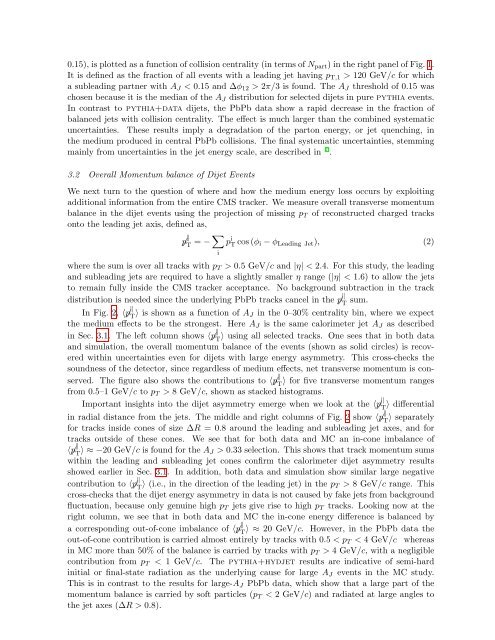2011 QCD and High Energy Interactions - Rencontres de Moriond ...
2011 QCD and High Energy Interactions - Rencontres de Moriond ...
2011 QCD and High Energy Interactions - Rencontres de Moriond ...
You also want an ePaper? Increase the reach of your titles
YUMPU automatically turns print PDFs into web optimized ePapers that Google loves.
0.15), is plotted as a function of collision centrality (in terms of Npart) in the right panel of Fig. 1.<br />
It is <strong>de</strong>fined as the fraction of all events with a leading jet having pT,1 > 120 GeV/c for which<br />
a subleading partner with AJ < 0.15 <strong>and</strong> ∆φ12 > 2π/3 is found. The AJ threshold of 0.15 was<br />
chosen because it is the median of the AJ distribution for selected dijets in pure pythia events.<br />
In contrast to pythia+data dijets, the PbPb data show a rapid <strong>de</strong>crease in the fraction of<br />
balanced jets with collision centrality. The effect is much larger than the combined systematic<br />
uncertainties. These results imply a <strong>de</strong>gradation of the parton energy, or jet quenching, in<br />
the medium produced in central PbPb collisions. The final systematic uncertainties, stemming<br />
mainly from uncertainties in the jet energy scale, are <strong>de</strong>scribed in 5 .<br />
3.2 Overall Momentum balance of Dijet Events<br />
We next turn to the question of where <strong>and</strong> how the medium energy loss occurs by exploiting<br />
additional information from the entire CMS tracker. We measure overall transverse momentum<br />
balance in the dijet events using the projection of missing pT of reconstructed charged tracks<br />
onto the leading jet axis, <strong>de</strong>fined as,<br />
p <br />
T<br />
<br />
= − p i T cos (φi − φLeading Jet), (2)<br />
i<br />
where the sum is over all tracks with pT > 0.5 GeV/c <strong>and</strong> |η| < 2.4. For this study, the leading<br />
<strong>and</strong> subleading jets are required to have a slightly smaller η range (|η| < 1.6) to allow the jets<br />
to remain fully insi<strong>de</strong> the CMS tracker acceptance. No background subtraction in the track<br />
distribution is nee<strong>de</strong>d since the un<strong>de</strong>rlying PbPb tracks cancel in the p <br />
T sum.<br />
In Fig. 2, 〈p <br />
T 〉 is shown as a function of AJ in the 0–30% centrality bin, where we expect<br />
the medium effects to be the strongest. Here AJ is the same calorimeter jet AJ as <strong>de</strong>scribed<br />
in Sec. 3.1. The left column shows 〈p <br />
T 〉 using all selected tracks. One sees that in both data<br />
<strong>and</strong> simulation, the overall momentum balance of the events (shown as solid circles) is recovered<br />
within uncertainties even for dijets with large energy asymmetry. This cross-checks the<br />
soundness of the <strong>de</strong>tector, since regardless of medium effects, net transverse momentum is conserved.<br />
The figure also shows the contributions to 〈p <br />
T 〉 for five transverse momentum ranges<br />
from 0.5–1 GeV/c to pT > 8 GeV/c, shown as stacked histograms.<br />
Important insights into the dijet asymmetry emerge when we look at the 〈p <br />
T 〉 differential<br />
in radial distance from the jets. The middle <strong>and</strong> right columns of Fig. 2 show 〈p <br />
T 〉 separately<br />
for tracks insi<strong>de</strong> cones of size ∆R = 0.8 around the leading <strong>and</strong> subleading jet axes, <strong>and</strong> for<br />
tracks outsi<strong>de</strong> of these cones. We see that for both data <strong>and</strong> MC an in-cone imbalance of<br />
〈p <br />
T 〉 ≈ −20 GeV/c is found for the AJ > 0.33 selection. This shows that track momentum sums<br />
within the leading <strong>and</strong> subleading jet cones confirm the calorimeter dijet asymmetry results<br />
showed earlier in Sec. 3.1. In addition, both data <strong>and</strong> simulation show similar large negative<br />
contribution to 〈p <br />
T 〉 (i.e., in the direction of the leading jet) in the pT > 8 GeV/c range. This<br />
cross-checks that the dijet energy asymmetry in data is not caused by fake jets from background<br />
fluctuation, because only genuine high pT jets give rise to high pT tracks. Looking now at the<br />
right column, we see that in both data <strong>and</strong> MC the in-cone energy difference is balanced by<br />
a corresponding out-of-cone imbalance of 〈p <br />
T 〉 ≈ 20 GeV/c. However, in the PbPb data the<br />
out-of-cone contribution is carried almost entirely by tracks with 0.5 < pT < 4 GeV/c whereas<br />
in MC more than 50% of the balance is carried by tracks with pT > 4 GeV/c, with a negligible<br />
contribution from pT < 1 GeV/c. The pythia+hydjet results are indicative of semi-hard<br />
initial or final-state radiation as the un<strong>de</strong>rlying cause for large AJ events in the MC study.<br />
This is in contrast to the results for large-AJ PbPb data, which show that a large part of the<br />
momentum balance is carried by soft particles (pT < 2 GeV/c) <strong>and</strong> radiated at large angles to<br />
the jet axes (∆R > 0.8).








![List of participants 27/2/09 [pdf] - Rencontres de Moriond - IN2P3](https://img.yumpu.com/17975746/1/190x135/list-of-participants-27-2-09-pdf-rencontres-de-moriond-in2p3.jpg?quality=85)







